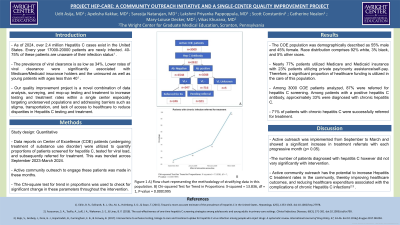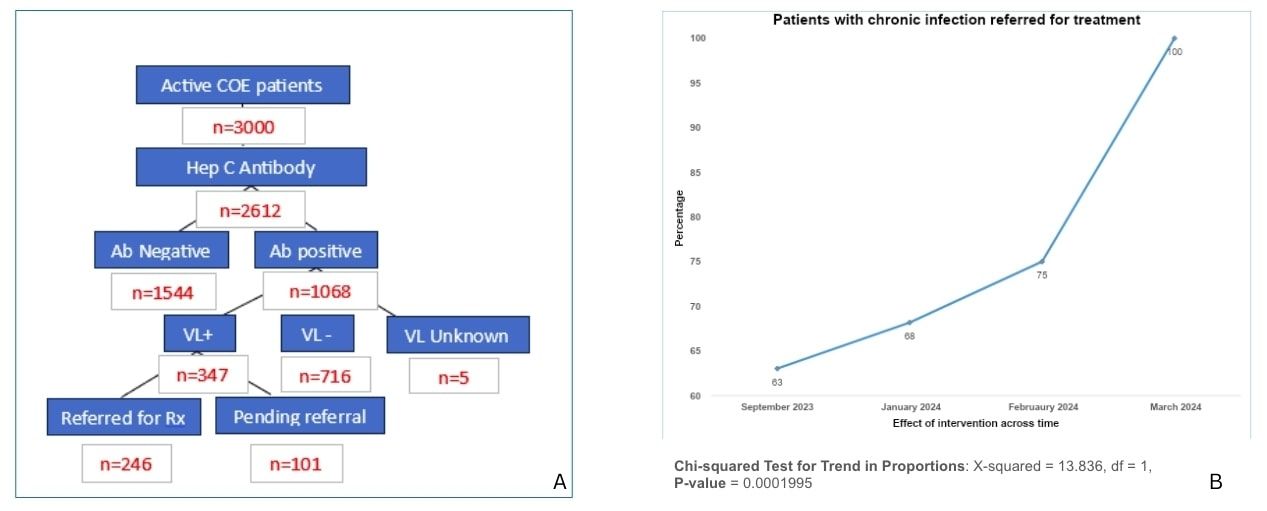Sunday Poster Session
Category: Liver
P1198 - Project Hep-Care: A Community Outreach Initiative and a Single-center Quality Improvement Project
Sunday, October 27, 2024
3:30 PM - 7:00 PM ET
Location: Exhibit Hall E

Has Audio

Udit Asija, MD
The Wright Center for Graduate Medical Education
throp, PA
Presenting Author(s)
Udit Asija, MD1, Apeksha Kakkar, MD2, Sarasija Natarajan, MD2, Lakshmi Priyanka Pappoppula, MD2, Scott Constantini, 2, Catherine Nealon, 2, Vikas Khurana, MD1, Mary-Loiuse Decker, MD, FIDSA2
1The Wright Center for Graduate Medical Education, Scranton, PA; 2The Wright Center for Community Health, Scranton, PA
Introduction: As of 2024, over 2.4 million Hepatitis C cases exist in the United States. Every year 17000-20000 patients are newly infected. 40-75% of these patients are unaware of their infection status. The prevalence of viral clearance was as low as 34%. Lower rates of viral clearance were significantly associated with Medicare/Medicaid insurance holders and the uninsured as well as young patients with ages less than 40. Our project is a novel combination of data analysis, surveying, and mop-up testing and treatment to increase Hepatitis C testing and treatment rates within a single center especially targeting underserved populations and addressing barriers such as stigma, transportation, and lack of access to healthcare to reduce disparities in Hepatitis C testing and treatment.
Methods: Study design: Quantitative
Data reports on Center of Excellence (COE) patients (undergoing treatment of substance use disorder) were utilized to quantify proportions of patients screened for hepatitis C, tested for viral load, and subsequently referred for treatment. This was trended across September 2023-March 2024. Active community outreach to engage these patients was made in these months. The Chi-square test for trend in proportions was used to check for significant change in these parameters throughout the intervention.
Results: The COE population was demographically described as 55% male and 45% female. Race distribution comprises 92% white, 3% black, and 5% other races. Nearly 77% patients utilized Medicare and Medicaid insurance with 23% patients utilizing private pay/county assistance/self-pay. Therefore, a significant proportion of healthcare funding is utilized in the care of this population. Among 3000 COE patients analyzed, 87% were referred for hepatitis C screening. Among patients with a positive hepatitis C antibody, approximately 33% were diagnosed with chronic hepatitis C. 71% of patients with chronic hepatitis C were successfully referred for treatment.
Discussion: Active outreach was implemented from September to March and showed a significant increase in treatment referrals with each progressive month (p< 0.05). The number of patients diagnosed with hepatitis C however did not vary significantly with intervention. Active community outreach has the potential to increase Hepatitis C treatment rates, thereby reducing rates of transmission in the community, thereby improving healthcare outcomes, and reducing healthcare expenditure associated with the complications of chronic Hepatitis C infections.

Disclosures:
Udit Asija, MD1, Apeksha Kakkar, MD2, Sarasija Natarajan, MD2, Lakshmi Priyanka Pappoppula, MD2, Scott Constantini, 2, Catherine Nealon, 2, Vikas Khurana, MD1, Mary-Loiuse Decker, MD, FIDSA2. P1198 - Project Hep-Care: A Community Outreach Initiative and a Single-center Quality Improvement Project, ACG 2024 Annual Scientific Meeting Abstracts. Philadelphia, PA: American College of Gastroenterology.
1The Wright Center for Graduate Medical Education, Scranton, PA; 2The Wright Center for Community Health, Scranton, PA
Introduction: As of 2024, over 2.4 million Hepatitis C cases exist in the United States. Every year 17000-20000 patients are newly infected. 40-75% of these patients are unaware of their infection status. The prevalence of viral clearance was as low as 34%. Lower rates of viral clearance were significantly associated with Medicare/Medicaid insurance holders and the uninsured as well as young patients with ages less than 40. Our project is a novel combination of data analysis, surveying, and mop-up testing and treatment to increase Hepatitis C testing and treatment rates within a single center especially targeting underserved populations and addressing barriers such as stigma, transportation, and lack of access to healthcare to reduce disparities in Hepatitis C testing and treatment.
Methods: Study design: Quantitative
Data reports on Center of Excellence (COE) patients (undergoing treatment of substance use disorder) were utilized to quantify proportions of patients screened for hepatitis C, tested for viral load, and subsequently referred for treatment. This was trended across September 2023-March 2024. Active community outreach to engage these patients was made in these months. The Chi-square test for trend in proportions was used to check for significant change in these parameters throughout the intervention.
Results: The COE population was demographically described as 55% male and 45% female. Race distribution comprises 92% white, 3% black, and 5% other races. Nearly 77% patients utilized Medicare and Medicaid insurance with 23% patients utilizing private pay/county assistance/self-pay. Therefore, a significant proportion of healthcare funding is utilized in the care of this population. Among 3000 COE patients analyzed, 87% were referred for hepatitis C screening. Among patients with a positive hepatitis C antibody, approximately 33% were diagnosed with chronic hepatitis C. 71% of patients with chronic hepatitis C were successfully referred for treatment.
Discussion: Active outreach was implemented from September to March and showed a significant increase in treatment referrals with each progressive month (p< 0.05). The number of patients diagnosed with hepatitis C however did not vary significantly with intervention. Active community outreach has the potential to increase Hepatitis C treatment rates, thereby reducing rates of transmission in the community, thereby improving healthcare outcomes, and reducing healthcare expenditure associated with the complications of chronic Hepatitis C infections.

Figure: Figure 1 A) Flow chart representing the methodology of stratifying data in this population.
B) Chi-squared Test for Trend in Proportions: X-squared = 13.836, df = 1, P-value = 0.0001995
B) Chi-squared Test for Trend in Proportions: X-squared = 13.836, df = 1, P-value = 0.0001995
Disclosures:
Udit Asija indicated no relevant financial relationships.
Apeksha Kakkar indicated no relevant financial relationships.
Sarasija Natarajan indicated no relevant financial relationships.
Lakshmi Priyanka Pappoppula indicated no relevant financial relationships.
Scott Constantini indicated no relevant financial relationships.
Catherine Nealon indicated no relevant financial relationships.
Vikas Khurana indicated no relevant financial relationships.
Mary-Loiuse Decker indicated no relevant financial relationships.
Udit Asija, MD1, Apeksha Kakkar, MD2, Sarasija Natarajan, MD2, Lakshmi Priyanka Pappoppula, MD2, Scott Constantini, 2, Catherine Nealon, 2, Vikas Khurana, MD1, Mary-Loiuse Decker, MD, FIDSA2. P1198 - Project Hep-Care: A Community Outreach Initiative and a Single-center Quality Improvement Project, ACG 2024 Annual Scientific Meeting Abstracts. Philadelphia, PA: American College of Gastroenterology.
